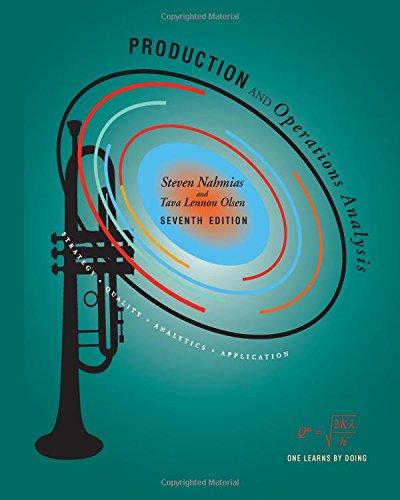Question
Farmer Brown, a farmer in Eastern Washington state, has a decision to make. Brown is growing 1,000 acres of winter wheat, which will be harvested
Farmer Brown, a farmer in Eastern Washington state, has a decision to make. Brown is growing 1,000 acres of winter wheat, which will be harvested and sold in two months. There are two things that are uncertain: Brown does not know how much wheat he will harvest and he does not know the price he will be paid for his wheat. He has been approached by a wheat broker, Mr. Fontaine, who has offered to pay Brown $390,000 dollars as a lump sum for his crop, thereby removing all uncertainty for Brown. Brown is wondering whether he should accept Fontaine's proposal.
The size of Brown's crop depends on the weather in Eastern Washington. The weather will be either wet or dry and Brown believes that there is a 20% chance that the weather in Eastern Washington will be wet. If the weather is wet, Brown will get 100 bushels of wheat per acre, for a total crop of 100,000 bushels. If the weather is dry he will get 150 bushels per acre, for a total of 150,000 bushels.
The price of wheat in two months will be determined by the supply of wheat from two sources, Eastern Washington (where Brown's farm is located) and the Prairie Provinces of Canada. Figure 1 below describes the relationship between total supply and price. The supply of wheat from Eastern Washington depends on the weather in Eastern Washington: if the weather is wet, Eastern Washington will supply 6 million bushels, and, if the weather is dry, Eastern Washington will supply 10 million bushels. The supply from the Prairie Provinces depends on the weather there. If it is wet in the Prairie Provinces, the Prairie Provinces will supply 12 million bushels. If it is dry in the Prairie Provinces, the Prairie Provinces will supply 20 million bushels. Hint: you may want to build a table to organize this information better you will need it to get the right payoffs!
There is a 20% chance that Eastern Washington will be wet. If Eastern Washington is wet, there is a 50% chance that the Prairie Provinces will also be wet. But if Eastern Washington is dry, there is only an 18.75% chance that the Prairie Provinces will be wet. Hint: note that there are 2 uncertainties the weather in Eastern Washington and the weather in Prairie Provinces. Your decision tree will have two uncertainty nodes (circles) next to each other in other words, an uncertainty node will have branches which lead to a second uncertainty node! Figure 1: Supply/Price Relationship

Suppose Brown could (hypothetically) obtain perfect information on the weather in both Eastern Washington and the Prairie Provinces. How much would such information be worth?
$6.00 18. $5.00 $5.00 22. 54.00 $4.00 Market Price for Wheat ( per bushel) 26. $3.00 $3.00 30, $2.50 $2.00 $1.00 10 40 15 20 25 30 35 Total Supply of Wheat from Eastern Washington and Prairie Provinces (millions of bushels) Figure 1: Supply/Price Relationship $6.00 18. $5.00 $5.00 22. 54.00 $4.00 Market Price for Wheat ( per bushel) 26. $3.00 $3.00 30, $2.50 $2.00 $1.00 10 40 15 20 25 30 35 Total Supply of Wheat from Eastern Washington and Prairie Provinces (millions of bushels) Figure 1: Supply/Price RelationshipStep by Step Solution
There are 3 Steps involved in it
Step: 1

Get Instant Access to Expert-Tailored Solutions
See step-by-step solutions with expert insights and AI powered tools for academic success
Step: 2

Step: 3

Ace Your Homework with AI
Get the answers you need in no time with our AI-driven, step-by-step assistance
Get Started


